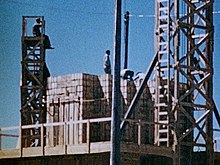| Timelines of World War II |
|---|
| Chronological |
| Prelude |
| By topic |
| By theatre |
The Manhattan Project was a research and development project that produced the first atomic bombs during World War II. It was led by the United States with the support of the United Kingdom and Canada. From 1942 to 1946, the project was under the direction of Major General Leslie Groves of the US Army Corps of Engineers. The Army component of the project was designated the Manhattan District; "Manhattan" gradually became the codename for the entire project. Along the way, the project absorbed its earlier British counterpart, Tube Alloys. The Manhattan Project began modestly in 1939, but grew to employ more than 130,000 people and cost nearly US$2 billion (about $35.4 billion in 2023[1] dollars). Over 90% of the cost was for building factories and producing the fissionable materials, with less than 10% for development and production of the weapons.[2][3]
Two types of atomic bombs were developed during the war. A relatively simple gun-type fission weapon was made using uranium-235, an isotope that makes up only 0.7 percent of natural uranium. Since it is chemically identical to the most common isotope, uranium-238, and has almost the same mass, it proved difficult to separate. Three methods were employed for uranium enrichment: electromagnetic, gaseous and thermal. Most of this work was performed at Oak Ridge, Tennessee. In parallel with the work on uranium was an effort to produce plutonium. Reactors were constructed at Oak Ridge and Hanford, Washington, in which uranium was irradiated and transmuted into plutonium. The plutonium was then chemically separated from the uranium. The gun-type design proved impractical to use with plutonium so a more complex implosion-type nuclear weapon was developed in a concerted design and construction effort at the project's principal research and design laboratory in Los Alamos, New Mexico.
The following is a timeline of the Manhattan Project. It includes a number of events prior to the official formation of the Manhattan Project, and a number of events after the atomic bombings of Hiroshima and Nagasaki, until the Manhattan Project was formally replaced by the Atomic Energy Commission in 1947.







- ^ 1634–1699: McCusker, J. J. (1997). How Much Is That in Real Money? A Historical Price Index for Use as a Deflator of Money Values in the Economy of the United States: Addenda et Corrigenda (PDF). American Antiquarian Society. 1700–1799: McCusker, J. J. (1992). How Much Is That in Real Money? A Historical Price Index for Use as a Deflator of Money Values in the Economy of the United States (PDF). American Antiquarian Society. 1800–present: Federal Reserve Bank of Minneapolis. "Consumer Price Index (estimate) 1800–". Retrieved 29 February 2024.
- ^ Nichols 1987, pp. 34–35.
- ^ "Atomic Bomb Seen as Cheap at Price". Edmonton Journal. 7 August 1945. p. 1. Retrieved 1 January 2012.
- ^ "The Calutron Girls". SmithDRay. Retrieved 22 June 2011.
- ^ Beck, Alfred M, et al., United States Army in World War II: The Technical Services – The Corps of Engineers: The War Against Germany, 1985 Chapter 24, "Into the Heart of Germany", p. 558